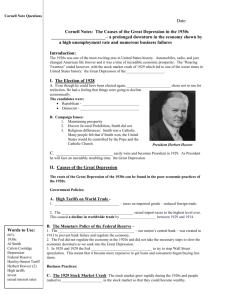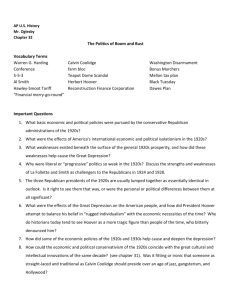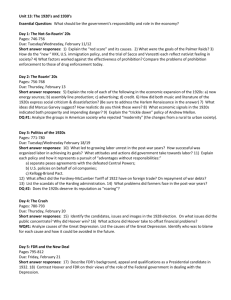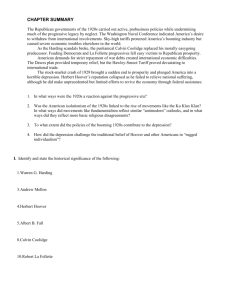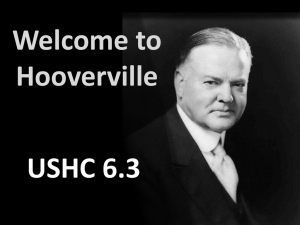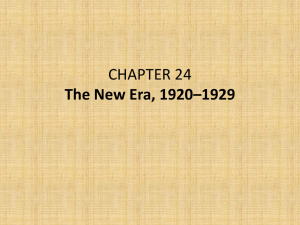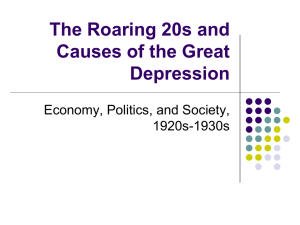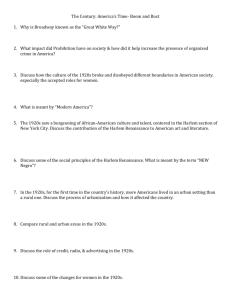Stanley K
advertisement
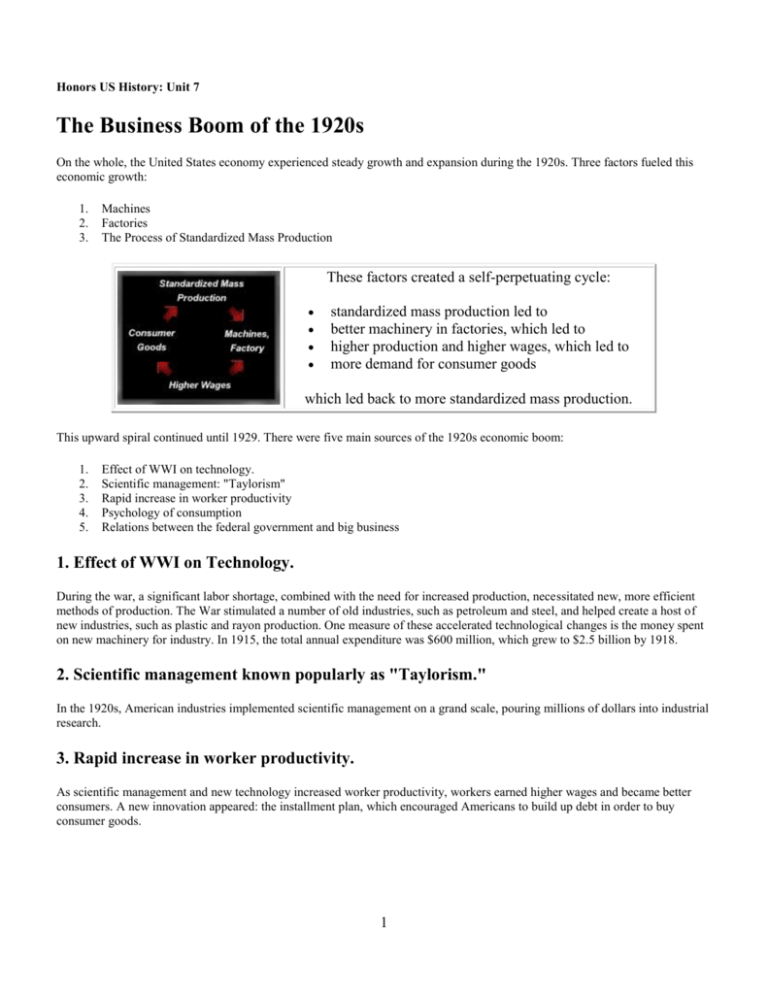
Honors US History: Unit 7 The Business Boom of the 1920s On the whole, the United States economy experienced steady growth and expansion during the 1920s. Three factors fueled this economic growth: 1. 2. 3. Machines Factories The Process of Standardized Mass Production These factors created a self-perpetuating cycle: standardized mass production led to better machinery in factories, which led to higher production and higher wages, which led to more demand for consumer goods which led back to more standardized mass production. This upward spiral continued until 1929. There were five main sources of the 1920s economic boom: 1. 2. 3. 4. 5. Effect of WWI on technology. Scientific management: "Taylorism" Rapid increase in worker productivity Psychology of consumption Relations between the federal government and big business 1. Effect of WWI on Technology. During the war, a significant labor shortage, combined with the need for increased production, necessitated new, more efficient methods of production. The War stimulated a number of old industries, such as petroleum and steel, and helped create a host of new industries, such as plastic and rayon production. One measure of these accelerated technological changes is the money spent on new machinery for industry. In 1915, the total annual expenditure was $600 million, which grew to $2.5 billion by 1918. 2. Scientific management known popularly as "Taylorism." In the 1920s, American industries implemented scientific management on a grand scale, pouring millions of dollars into industrial research. 3. Rapid increase in worker productivity. As scientific management and new technology increased worker productivity, workers earned higher wages and became better consumers. A new innovation appeared: the installment plan, which encouraged Americans to build up debt in order to buy consumer goods. 1 4. Psychology of consumption. In a variety of ways, Americans wanted to get rich, and to do so with little effort. Thorstein Veblen, an economist, published The Theory of the Leisure Class in 1898. The book reached a wide American audience during the 1920s because it spoke directly to the psychology of American consumption. Veblen, in fact, introduced the now-familiar term "conspicuous consumption," which seemed to embody the cultural mindset of post World War I America. Some examples of conspicuous consumption include: Radio The first commercial radio station went on the air in the 1920s in Pittsburgh, while the first public radio station opened on the campus of the University of Wisconsin. By 1922, 3 million American households had radios, and purchases of receivers had increased by 2,500%, giving the industry annual sales of $850 million by 1929. Radio broadcasting from the University of Wisconsin Fieldhouse during a basketball game Copyright 1997 State Historical Society of Wisconsin Motion pictures A fledgling industry before World War I, motion picture production became one of the ten largest industries in the United States during the 1920s. In 1922, theaters sold 40 million tickets a week. By 1929, that number had grown to 100 million a week. One of the capitalists who cashed in on Hollywood was Joseph P. Kennedy, patriarch of the Kennedy's, one of the nation's most influential political families. During eight months in Hollywood, he made $6 million. New electric appliances A floodtide of new electric appliances lightened the load of the middle-class American housewife: vacuum cleaners, toasters, washing machines, refrigerators. Women became America's greatest consumers, purchasing appliances and other items that would have been considered a luxury just a generation before. Automobile industry Nowhere was the psychology of consumption more evident than in the automobile industry. Annual automobile production rose from 2 million during the 1920s to 5.5 million in 1929. By the late 1920s, there was one automobile for every five Americans, allowing, theoretically, for every person in the United States to be on the road at the same time. Two factors led to the rising popularity of cars: 1. Cost-- The price of automobiles declined steadily until the mid-1920s so that many well-paid working families could now afford to purchase a car. The Model T Ford, for example, cost just $290 in 1926. 2. Credit-- In 1925, Americans made 75% of all automobile purchases on the installment plan. 2 Economic Effects of the Automobile: 1. 2. 3. Promoted growth of other industries. Especially petroleum, rubber, and steel. Helped fuel the creation of a national system of highways. Automobiles required better roads. After WWI, federal funds became available for building highways and a major industry was born. Created new service facilities. Filling stations, garages, and roadside restaurants sprang up across the nation. Motels (the word itself is a blend of 'motor' and 'hotel') catering to the needs of motorists began to replace hotels. Social Effects of the Automobile: 1. 2. 3. Created a more mobile society. Cars broke down the distinctions between urban and rural America. With the automobile came the new tradition of the "Sunday drive," and many city folks got their first chance to tour the rural countryside. Rural Americans, on the other hand, drove into cities to shop and to be entertained. Broke down the stability of family life. Now it was far easier for individual family members to go their own way. Broke down traditional morality. Children could escape parental supervision as cars became a sort of "bedroom on wheels." In 1929, sociologists Robert and Helen Lynd published, Middletown, a book based on field research done in Muncie, Indiana, in 1924 and 1925. The Lynds explored how industrialization had transformed tradition values and customs in Middle America. They paid particular attention to people's changing attitudes toward the automobile. They found that people of every income level considered the automobile a necessity rather than an luxury. People were willing to sacrifice food, clothing, and their savings in order to own a car. 5. Relations between the federal government and big business. American businessmen regained the status of folk hero they had enjoyed in the days before Progressivism. Many Americans began to equate prosperity with progress. There were some critics of America's culture of consumption, including Sinclair Lewis, author of the novel Babbitt (1922). Lewis poked fun at the average businessman as a materialistic, amoral, superficial conformist. Other popular books painted a different picture. Bruce Barton, a prominent figure in advertising, published, The Man Nobody Knows: A Biography of Jesus, in 1925. Barton presented Jesus as the "founder of modern business" and the apostles as the "greatest sales force in history." Relationships between businessmen and government had never been closer than they were in the 1920s. Calvin "Silent Cal" Coolidge piped up: "Wealth is the chief end of man!" and slightly less laconically: "The man who builds a factory, builds a temple. The man who works there, worships there." "The American Way" Businessmen had two major propaganda mills: the Chamber of Commerce and the National Association of Manufacturers. Both groups preached a return to laissez-faire economics, less government regulation of business, and less government support for 3 labor unions. The National Association of Manufacturers labeled this program, "The American Way." President Harding spoke for himself and for his successors, Coolidge and Hoover, when he asked for "less government in business and more business in government." There were four major ways in which the federal government supported big business. 1. 2. 3. 4. High tariff policies. The Fordney-McCumber Act (1922) and the Hawley-Smoot Act (1930) created the highest-ever schedule of tariffs for foreign-made goods. Andrew Mellon. Secretary of the Treasury from 1921 to 1932. In response to his demands, Congress repealed the excess profits tax and reduced the rates for corporate and personal income taxes. Mellon provided business leaders with a list of tax loopholes which the IRS had drawn up at Mellon's request. Cutbacks in the Federal Trade Commission (FTC). The federal government had created the FTC to regulate big business and to look into unfair trade practices, but the commission did less and less of this in the 1920s. Herbert Hoover. As Secretary of Commerce and as President, Hoover encouraged price-fixing and believed that the government was responsible for helping businesses profit. Not everyone took part in the material successes of the 1920s. This decade also saw growing racism and nativism, increasing frustration from those who felt cut off from prosperity. Crashing Hopes: The Great Depression In 1929, Yale University economist Irving Fisher stated confidently: "The nation is marching along a permanently high plateau of prosperity." Five days later, the bottom dropped out of the stock market and ushered in the Great Depression, the worst economic downturn in American history. Although Americans often believe that the Crash was the starting point of the Great Depression, many historians point out that it wasn't the sole cause. This lecture examines the roots of the Crash and the effect of the Great Depression on the American public. Some questions to keep in mind: 1. 2. 3. 4. 5. Why were Americans so confident in the stock market in the years leading up to the Great Depression? How did the Psychology of Consumption shape the causes and effects of the Crash? How did stock market investing change during the 1920s? Who were the main investors and how did they pay for their investments? Explain the statement: "By 1929, much of the money that was invested in the stock market did not actually exist." Why did Hoover choose the term "depression" for this economic downturn? Why do you think this term has remained part of the American vocabulary ever since? Optimism and Prosperity When Americans elected Herbert Hoover President in 1928, the mood of the general public was one of optimism and confidence in the United States economy. Most people believed that national prosperity would continue indefinitely. In his acceptance speech for the Republican party nomination for the presidency, Hoover had said: "We in America today are nearer to the final triumph over poverty than ever before in the history of any land. The poorhouse is vanishing from among us." Many Americans shared Hoover's optimism at the beginning of 1929. An editorial in the New Year's edition of the New York Times on January 1, 1929, for example, stated: "It has been twelve months of unprecedented advance, of wonderful prosperity. If there is any way of judging the future by the past, this new year will be one of felicitation and hopefulness." 4 That same year, John Jacob Raskob, Chief Executive of General Motors and head of the Democratic National Committee, published an article entitled "Everybody Ought to be Rich" in the Ladies Home Journal. Raskob suggested that every American could become wealthy by investing $15 a week in common stocks. He failed to realize, however, that the weekly salary of the average American worker was between $17 and $22, but that's not important: the optimism was there. A "Bull Market" For five years prior to 1929, rising prices typified the stock market. During this period, American investors enjoyed an enormous "bull market." (The opposite, a market characterized by falling prices, is called a "bear market."). Americans invested in the stock market for six reasons during the 1920s: 1. Rising stock dividends. New investors entering the market, many who viewed it as an easy way to get rich quick, helped inflate stock prices. Economic historians, however, estimate that a relatively small number of Americans--about 4 million--had investments in the market at any one time. Yet, the constant influx of new investors coming in and old investors moving out ensured that new money was always floating around. 2. Increase in personal savings. Higher wages meant that even average Americans now had surplus money to put into savings or invest in the stock market. 3. Relatively easy money policy. At this time, banks made money more readily available at lower interest rates to more and more people. Although economists debate the actual influence of this phenomenon on the stock market, it's conceivable that many people took out loans not only to buy cars, but also to buy stock. 4. Companies invested their over-production profits in new production. From 1925 on, industry was over-producing. In anticipation of eventually selling the surplus, business leaders funneled their profits right back into industry. They invested in factories and new machinery, and hired more workers, which, in turn, fueled even greater overproduction. This increased production gave the companies an aura of financial soundness, which encouraged Americans to buy more stock. 5. Lack of stock market regulation. At this time, there were no effective legal guidelines on buying and selling stock. Free from such limitations, corporations began printing up more and more common stock. Many investors in the stock market practiced "buying on margin," that is, buying stock on credit. Confident that a given stock's value would rise, an investor put a down payment on the stock, expecting in a few months to pay off the balance of their initial investment while reaping a hefty profit. This investment strategy turned the stock market into a speculative pyramid game, in which most of the money invested in the market didn't actually exist. 6. Psychology of consumption. We've already discussed this phenomenon in Lecture 15. The Psychology of Consumption fed the optimism of investors and gave them unquestioning faith in prosperity. When the Crash did come, it was even more devastating because of this unquestioned faith. 5 The Crash Most economists of the 1920s believed that the stock market--not housing starts, sales of durable goods, or the financial health of banks--was the chief indicator of the fiscal health of the United States. In September of 1929, stock prices began to fluctuate, but market analysts dismissed this as temporary. What many of these analysts did not realize--or refused to admit--however, was that stock prices were totally out of proportion to actual profits. Sales of goods and the construction of factories were falling rapidly while stock values continued to climb. Still, very few were worried; they still accepted Adam Smith's "self-adjusting economy" as dogma and believed the problems would correct themselves. Historians refer to October 24, 1929 as "Black Thursday." On this day, people began dumping their stocks as quickly as they could. Sell orders inundated market exchanges and the bull market suddenly shifted to a bear market. By that evening, J.P. Morgan and other financiers bought up stock to stop the panic and keep the market afloat. On Friday, October 25, the House of Morgan continued to keep the market stable and it seemed that the panic was over. Yet, many investors began to worry during the weekend. George and Martha and thousands of their friends decided to sell whatever stock they still had as soon as the market opened on Monday. As a result, on Monday, October 28, there was another wave of sell orders. The next day, October 29, 1929, "Black Tuesday," was the beginning of the Great Crash. "Black Tuesday" was the single most devastating financial day in the history of the New York Stock Exchange. Within the first few hours the stock market was open, prices collapsed and wiped out all the financial gains of the previous year. Since most Americans viewed the stock market as the chief indicator of the health of the American economy, the Great Crash shattered public confidence. Between October 29 and November 13, the day when stock prices hit their lowest point, over $30 billion disappeared from the American economy. This amount was comparable to the total amount of money that the federal government had spent to fight the First World War. Still, optimism persisted and many leaders declared that the worst was over. J. D. Rockefeller said: "These are days when many are discouraged. In the 93 years of my life, depressions have come and gone. Prosperity has always returned and will again." Such optimism, however, did not last long. Popular songs of the day mirrored the transition from optimism to despair. In 1930, people sang "Happy Days Are Here Again" and the national income dropped from $87 billion to $75 billion. In 1931, somewhat more dejectedly, people sang "I've Got Five Dollars" and the nation's income dropped to $59 billion. The song of 1932 was "Brother, Can You Spare a Dime," when the domestic economy fell to $42 billion. Eventually, the American economy bottomed out at $40 billion in 1933. Former President Coolidge had this insightful observation about the economic health of the United States: "This country is not in good condition." The Depression So as not to alarm the public, President Hoover chose his words carefully when he discussed the state of the economy in 1929. American economists and politicians had referred to previous economic downturns as "Panics," such as the "Panic of 1873" and the "Panic of 1893." Hoover, however, called this latest downturn a "Depression" rather than a "Panic," and the name stuck. Of course, America was not alone in the Great Depression; it struck all the industrialized nations of the world, including Germany, Britain, and France. Moreover, Germany still had huge reparation payments to make to the Allies in the aftermath of WWI. These reparation payments fueled spiraling inflation in Germany and crippled that nation's economy. The Allies themselves had borrowed money from the United States during the war, were unable to pay it all back during the 1920s, and were now not only broke, but in debt. 6 Cracks in the Economic Foundation After the Great Crash, the American public sought a scapegoat for the economic collapse. Some held President Hoover responsible, others targeted the "three B's"--brokers, bankers, and businessmen. But the cause of the Great Depression could not be attributed to one individual or even a group of people. The roots of the Great Depression were in the very structure of the American economy, namely: 1. Unequal distribution of wealth and income. Despite rising wages overall, income distribution was unequal. Gaps in income had actually increased since the 1890s. The 1% of the population at the very top of the pyramid had incomes 650% greater than those 11% of Americans at the bottom of the pyramid. The tremendous concentration of wealth in the hands of a few meant that continued economic prosperity was dependent on the high investment and luxury spending of the wealthy. However, both the high spending and high investment of the time, much like today, were susceptible to economic fluctuations; they were much less stable than people's expenses on daily necessities like food, clothing, and shelter. Therefore, when the market crashed and the economy tumbled, both big spending and big investment collapsed, as well. Family lives on public relief funds (1936) Copyright 1997 State Historical Society of Wisconsin 2. Unequal distribution of corporate power. From the late 1870s on, there had been an ongoing movement of business consolidations and mergers in the United States. During WWI, many potential commercial competitors merged into huge corporations like General Electric and eliminated competition in major American industries. In 1929, two hundred of the biggest corporations controlled 50% of the nation's corporate wealth. This concentration of corporate wealth meant that if just a few companies went under after the Crash, the whole economy would suffer. 7 Some quick definitions: Trust - A combination of firms or corporations, that is now illegal, organized for the purpose of reducing competition and controlling prices throughout a business or industry. Holding company - A company that controls other companies. During the 1920s, holding companies came to replace trusts. 3. Bad banking structure. In the 1920s, banks were opening at the rate of four to five per day, but without many federal restrictions to determine how much start-up capital a bank needed or how much it could lend. As a result, most of these banks were highly insolvent. Between 1923 and 1929, banks closed at the rate of two a day. Yet, until the stock market crash in 1929, the nation's seemingly inevitable prosperity helped concealed the potentially fatal flaws in the American banking system. 4. Foreign balance of payments. World War I had turned the United States from a debtor nation into a creditor nation. In the aftermath of the war, both the victorious Allies and the defeated Central Powers owed the United States more money than it owed to foreign nations. The Republican administrations of the 1920s insisted on payments in gold bullion, but the world's gold supply was limited and by the end of the 1920s, the United States, itself, controlled much of the world's gold supply. Besides gold, which was increasingly in short supply, countries could pay their debts in goods and services. However, protectionism and high tariffs kept foreign goods out of the United States. Recall from Lecture 15 that the Hawley-Smoot Act (1930) set the highest schedule of tariffs to date. This protectionism produced a negative effect on United States exports: if foreign countries couldn't pay their debts, they had no money to buy American goods. 5. Limited or poor state of economic intelligence. Most American economists and political leaders in 1929 still believed in laissez-faire and the self-regulating economy. To help the economy along in its self-adjustment, President Hoover asked businesses to voluntarily hold down production and increase employment, but businesses couldn't keep up high employment for long when they weren't selling goods. There was a widespread belief that if the federal budget were balanced, the economy would bounce back. To balance the budget demanded no further tax cuts (although Hoover lowered taxes) and no increase in government spending, which was disastrous in light of rising unemployment and falling prices. Another problem with economic practices of the day was the commitment of the Hoover administration to remain on the international gold standard. Many analysts implored Hoover to increase the money supply and to devalue the dollar by printing paper money not backed by gold, but the president refused. Going off the gold standard was one of Roosevelt's first actions when he entered the White House in 1933. Stanley K. Schultz, Professor of History William P. Tishler, Producer http://us.history.wisc.edu/hist102/lectures/lecture15.html 8


